Tattoos are a popular form of body art, but one of the most common questions among those considering or getting inked is: How long does it take for a tattoo to heal? While the general healing process typically spans from 2 to 4 weeks, numerous factors can influence this timeline. Factors such as tattoo size, placement, and aftercare practices all play significant roles in determining the duration of healing. Understanding these factors is crucial for ensuring proper care and promoting a successful healing outcome. We will delve into these details further at the end of this article to provide comprehensive insights into the healing process of tattoos.
What is a Tattoo?
A tattoo is a permanent design or mark made on the skin by inserting pigment into the dermis layer through the use of needles. Tattoos can vary widely in design, size, and color, and they are often chosen for their personal, cultural, or aesthetic significance.
Different Types of Tattoos
Tattoos come in a wide variety of styles, each with its own techniques and aesthetics. Here are some popular types:
• UV Tattoo: Uses glow-in-the-dark ink that is visible under UV light.
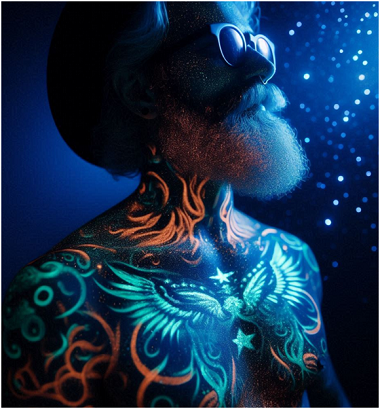
• Minimalist Tattoos: Characterized by simple, clean lines for a subtle effect.

• Negative Space Tattoos: Utilizes the skin as the outline or ‘negative space’ to create the design.

• Hand-poked Tattoos: A machine-free technique where the tattoo is applied dot by dot.

• Words and Phrases: Tattoos that feature letters as art, often with deep personal meanings.

• Floral Tattoos: Blossoms and flowers, each with their own symbolism and meanings.

• Line Art Tattoos: Continuous line designs that can be abstract or representational.
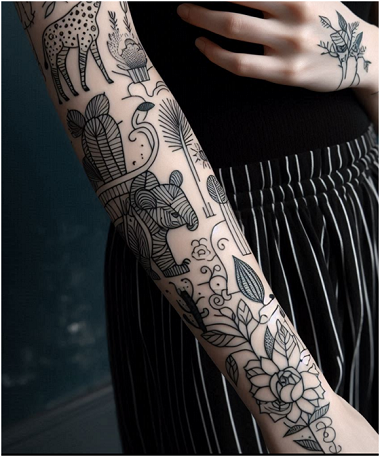
• Watercolor Tattoos: Have a painting-like effect with splashes of color and a soft finish.

• Abstract Tattoos: Non-representational art that can be based on shapes, lines, or colors.

• Geometric Tattoos: Composed of shapes and patterns, often with a symmetrical design.

•Blackwork Tattoos: Feature heavy use of black ink, often for bold and striking designs.

• American Traditional Tattoos: Old school style with bold lines and a limited color palette.

Each style has its own unique charm and can be chosen based on personal preference or the meaning behind the design. If you’re considering getting a tattoo, it’s important to research and find a skilled artist who specializes in the style you’re interested in.
Why Get a Tattoo?
Tattoos have been a part of human culture for thousands of years, serving various purposes and holding different meanings across societies. In modern times, people choose to get tattoos for a multitude of reasons. Here are some of the primary motivations behind getting a tattoo:
Personal Expression
Tattoos are a powerful form of self-expression. They allow individuals to visually convey their beliefs, values, experiences, and aspects of their personality. For many, a tattoo is a way to wear their story on their skin, making their inner world visible to others.
Artistic Appreciation
Many people are drawn to the artistic aspect of tattoos. They appreciate the skill and creativity involved in the tattooing process and view their bodies as canvases for wearable art. Tattoos can be a way to celebrate and support the art form and the talented artists who create these permanent works of art.
Commemoration and Memory
Tattoos often serve as a tribute to significant people, events, or milestones in one’s life. Whether it’s honoring a loved one who has passed away, marking a significant achievement, or remembering a pivotal moment, tattoos can hold deep personal significance and act as constant reminders of what is important.
Cultural and Spiritual Significance
For some, tattoos are rooted in cultural or spiritual traditions. Many indigenous cultures have long histories of tattooing as part of their heritage, with tattoos symbolizing rites of passage, spiritual beliefs, or social status. Even in contemporary society, some individuals get tattoos that reflect their spiritual or religious beliefs.
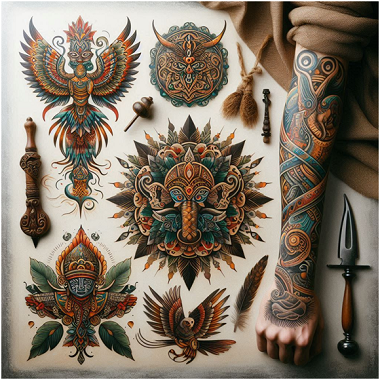
Tattoos hold deep cultural and spiritual significance in various societies. For instance, Maori Ta Moko tattoos in New Zealand signify identity and social status, while Samoan Pe’a and Malu tattoos mark rites of passage. Japanese Irezumi tattoos symbolize protection and wisdom with motifs like dragons and koi fish. Native American tribal tattoos often reflect achievements and spiritual beliefs. Thai SakYant tattoos, given by monks, are believed to provide protection and blessings. Hindu and Buddhist tattoos, such as mandalas, Om symbols, and lotus flowers, represent spiritual growth and enlightenment. Celtic tattoos symbolize eternity and interconnectedness, and African tribal tattoos mark significant life events and cultural identity. Each tradition reflects the profound cultural and spiritual meanings behind tattooing.
Identity and Belonging
Tattoos can also symbolize membership in a particular group or community. This could be a subculture, such as the punk or biker communities, or a more intimate group like a family or circle of friends who share matching tattoos. These tattoos foster a sense of identity and belonging, creating a bond among those who share them.
Aesthetic Appeal
Sometimes, people get tattoos simply because they find them beautiful. The aesthetic appeal of a well-designed tattoo can enhance one’s appearance and provide a sense of personal satisfaction. The choice of design, placement, and style allows for endless customization to suit individual tastes.
Empowerment and Reclamation
For some individuals, getting a tattoo can be an act of empowerment or reclamation. This might be in response to overcoming a personal struggle, reclaiming one’s body after trauma, or making a statement about independence and autonomy. Tattoos can serve as powerful symbols of strength, resilience, and personal victory.
In summary, the reasons for getting a tattoo are as diverse and unique as the people who choose to get them. Whether for personal expression, artistic appreciation, commemoration, cultural significance, identity, aesthetic appeal, or empowerment, tattoos hold a profound and lasting significance in the lives of those who wear them.
How is a Tattoo Done?
Getting a tattoo involves a meticulous process to ensure the design is accurately transferred to the skin and to minimize the risk of infection. Here is an overview of the steps involved in the tattooing process:
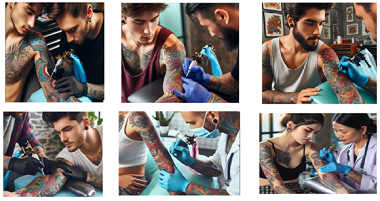
1. Consultation and Design
Consultation:
- The process begins with a consultation between the client and the tattoo artist. During this meeting, the client discusses their design ideas, placement, size, and any specific details they want in the tattoo.
- The artist may provide input on the design, suggest modifications, and help finalize the artwork.
Design Approval:
- Once the design is finalized, the artist creates a stencil or sketch of the tattoo. The client reviews and approves the design before proceeding.
2. Preparation
Sanitization:
- The tattoo artist sanitizes their hands and wears disposable gloves to maintain a sterile environment.
- All equipment, including needles and tubes, is sterilized, and disposable materials are used to prevent cross-contamination.
Skin Preparation:
- The area of the skin where the tattoo will be placed is cleaned with an antiseptic solution.
- If necessary, the area is shaved to remove any hair that could interfere with the tattooing process.
3. Stencil Application
Stencil Transfer:
- The tattoo artist applies a stencil of the design to the skin. This helps guide the artist during the tattooing process and ensures accuracy.
- The stencil is carefully positioned and pressed onto the skin, transferring the design outline.
4. Tattooing
Outlining:
- The artist begins by outlining the tattoo using a tattoo machine with a sterile needle. The outline is typically done in black ink to create a clear and defined shape.
- The client is advised to remain as still as possible to ensure precise lines.
Shading and Coloring:
- After the outline is complete, the artist adds shading and color to the tattoo. Different needles may be used for shading and coloring to achieve the desired effect.
- The artist carefully applies ink in layers, blending colors and creating depth.
Wiping and Cleaning:
- Throughout the tattooing process, the artist periodically wipes away excess ink and blood to maintain a clear view of the design.
- The area is continuously cleaned to prevent infection and ensure accuracy.
5. Completion and Aftercare
Final Cleaning:
- Once the tattoo is complete, the artist cleans the area with a mild antiseptic solution to remove any remaining ink and blood.
Aftercare Instructions:
- The artist provides detailed aftercare instructions to the client. This typically includes guidance on how to clean and protect the tattoo, what products to use, and what activities to avoid during the healing process.
- A protective bandage or wrap may be applied to the tattoo to keep it clean and prevent infection.
Getting a tattoo is a collaborative process that requires careful planning, precision, and proper aftercare. By following these steps, both the tattoo artist and the client can ensure a safe and satisfying tattooing experience.
Precautions for Getting a Tattoo
Getting a tattoo is a significant decision that requires careful consideration and preparation. To ensure a safe and successful tattooing experience, it’s important to take certain precautions:
1. Research the Tattoo Studio
- Hygiene Standards: Choose a reputable tattoo studio with high hygiene standards. Ensure that the studio follows strict sterilization protocols for equipment and maintains a clean environment.
- Artist Credentials: Research the credentials and experience of the tattoo artist. Look for reviews, portfolios of their work, and certifications from recognized organizations.
2. Communicate Clearly
- Design and Placement: Clearly communicate your design ideas, placement preferences, and any concerns to the tattoo artist during the consultation. Make sure you are both on the same page before proceeding.
- Medical History: Inform the tattoo artist of any medical conditions, allergies, or medications you are taking. Certain health conditions or medications may affect the tattooing process or healing.
3. Practice Good Aftercare
- Follow Aftercare Instructions: Pay close attention to the aftercare instructions provided by the tattoo artist. This may include washing and moisturizing the tattooed area, avoiding exposure to sunlight and water, and refraining from picking at scabs.
- Monitor for Infection: Keep an eye on the tattoo for signs of infection, such as redness, swelling, or discharge. If you suspect an infection, seek medical attention promptly.
4. Choose the Right Design and Size
- Consider the Design: Choose a tattoo design that holds personal significance and reflects your style and personality. Avoid trendy designs that may lose their appeal over time.
- Size and Placement: Carefully consider the size and placement of the tattoo. Think about how it will fit with your body contours and whether it can be easily concealed if needed.
5. Take Care of Your Health
- Avoid Alcohol and Drugs: Refrain from consuming alcohol or drugs before getting a tattoo. These substances can thin the blood and increase the risk of bleeding during the tattooing process.
- Stay Hydrated and Well-Rested: Ensure you are well-hydrated and well-rested before getting a tattoo. This will help your body cope better with the stress of the tattooing process and promote faster healing.
6. Be Patient and Mindful
- Avoid Impulsivity: Take your time to think through your decision to get a tattoo. Avoid getting tattooed on a whim, as you may regret it later.
- Stay Calm: Try to remain calm and relaxed during the tattooing process. Deep breathing exercises or listening to music can help alleviate anxiety.
By following these precautions, you can minimize the risks associated with getting a tattoo and increase the likelihood of a positive and satisfying experience. Remember that getting a tattoo is a personal choice, and it’s essential to approach it with careful consideration and preparation.
Treatments for Tattoos
Tattoos can require various treatments throughout their lifecycle, from initial aftercare following the tattooing process to removal if desired. Here are the primary treatments associated with tattoos:
1. Aftercare for New Tattoos
Proper aftercare is essential to ensure a tattoo heals correctly and retains its quality:
- Cleaning: Gently wash the tattooed area with mild soap and lukewarm water. This should be done 2-3 times a day during the initial healing period.
- Moisturizing: Apply a thin layer of a recommended ointment or fragrance-free moisturizer to keep the skin hydrated and promote healing.
- Protection: Avoid direct sunlight and do not submerge the tattoo in water (such as swimming pools or hot tubs) until it has fully healed. Wear loose clothing to prevent irritation.
- Avoid Picking or Scratching: Do not pick at scabs or scratch the tattooed area, as this can cause infection and damage the tattoo.
2. Managing Complications
Sometimes complications can arise, and these require specific treatments:
- Infection: Symptoms of infection include redness, swelling, pain, and pus. If an infection is suspected, seek medical attention promptly. Treatment typically involves antibiotics.
- Allergic Reactions: Some individuals may develop an allergic reaction to the tattoo ink. This can cause itching, redness, and swelling. Over-the-counter antihistamines may help, but severe reactions require medical intervention.
- Scarring: If a tattoo is not properly cared for, it can result in scarring. Use of silicone sheets or gels and laser treatments can help reduce the appearance of scars.
3. Touch-ups and Maintenance
Over time, tattoos can fade or lose their sharpness. Touch-ups involve:
- Reapplying Ink: A tattoo artist will go over the existing tattoo to refresh the colors and sharpen the lines.
- Regular Moisturization: Keeping the skin hydrated helps maintain the tattoo’s vibrancy.
4. Tattoo Removal
For those who wish to remove their tattoos, several options are available:
- Laser Removal: This is the most common and effective method. A laser breaks down the ink particles, which are then absorbed by the body. Multiple sessions are often required.
- Dermabrasion: This method involves sanding down the skin to remove the tattoo. It is less commonly used due to the risk of scarring and infection.
- Surgical Excision: For small tattoos, surgical removal may be an option. The tattooed skin is cut out, and the remaining skin is stitched together. This method also carries a risk of scarring.
- Tattoo Removal Creams: These are less effective and often require a prolonged application period. Results vary widely and they are generally not recommended by dermatologists.
5. Cover-ups
If complete removal is not desired or feasible, a tattoo cover-up is an alternative:
- Design Integration: A skilled tattoo artist can design a new tattoo to cover the existing one, effectively masking it with new art. This requires careful planning to ensure the old tattoo is adequately covered and the new design is cohesive.
By following proper aftercare, managing any complications promptly, and understanding the options for touch-ups or removal, individuals can ensure their tattoos remain a positive aspect of their personal expression.
What Happens If Something Goes Wrong with a Tattoo?
If anything goes wrong during or after getting a tattoo, several potential complications may arise. These can vary in severity and may include:
- Infection: If proper hygiene practices are not followed during the tattooing process or during the healing period, bacterial infections may occur. Symptoms of infection include redness, swelling, warmth, and discharge from the tattooed area. In severe cases, an infection can lead to fever and may require medical treatment with antibiotics.
- Allergic Reaction: Some individuals may develop an allergic reaction to the tattoo ink or other components used during the tattooing process. Symptoms can include itching, redness, swelling, and rash at the tattoo site. In rare cases, severe allergic reactions may occur, leading to anaphylaxis, which requires immediate medical attention.
- Scarring: Improper tattooing techniques or inadequate aftercare can result in scarring. Keloid scars, which are thick, raised scars that extend beyond the boundaries of the tattoo, may develop in some individuals, particularly those with a predisposition to keloid formation.
- Skin Conditions: Existing skin conditions, such as psoriasis or eczema, may be exacerbated by tattooing. The tattooed area may become inflamed, itchy, or develop a rash. In some cases, the tattoo may need to be removed or covered to alleviate the symptoms.
- Unsatisfactory Results: If the tattoo artist does not accurately execute the desired design or if the ink does not heal as expected, the individual may be dissatisfied with the appearance of the tattoo. In such cases, options for correction or removal may be explored, but these processes can be time-consuming, costly, and may not always yield the desired outcome.
- Emotional Impact: For some individuals, experiencing complications with a tattoo can have emotional repercussions. This may include feelings of regret, embarrassment, or disappointment. Seeking support from friends, family, or a mental health professional can help address these emotional concerns.
It’s essential to carefully consider the potential risks and complications associated with getting a tattoo and to choose a reputable tattoo artist and studio. Additionally, following proper aftercare instructions and promptly addressing any concerns with a healthcare provider can help mitigate the risk of complications and ensure a positive tattooing experience.
Tattoo Aftercare
Tattoo aftercare is essential for ensuring proper healing and maintaining the appearance of your tattoo. Here are some general guidelines:
- Keep it clean: Gently wash your tattoo with mild, unscented soap and water. Avoid scrubbing or rubbing the tattoo, as this can irritate the skin.
- Moisturize: Apply a thin layer of fragrance-free moisturizer or tattoo-specific aftercare lotion to keep the skin hydrated and prevent it from drying out.
- Avoid sun exposure: Protect your tattoo from direct sunlight and tanning beds, as UV rays can fade the ink and increase the risk of skin damage.
- Avoid swimming: Avoid soaking your tattoo in pools, hot tubs, or baths, as prolonged exposure to water can delay healing and increase the risk of infection.
- Avoid picking or scratching: It’s essential to resist the urge to pick at scabs or scratch your tattoo, as this can damage the skin and affect the final appearance of the tattoo.
- Follow aftercare instructions: Your tattoo artist will provide specific aftercare instructions tailored to your tattoo. Follow these instructions carefully to ensure optimal healing and long-term tattoo health.
If you have any concerns or notice signs of infection during the healing process, consult with your tattoo artist or a healthcare professional for guidance.
How Long Does It Take for a Tattoo to Heal?
The healing time for a tattoo can vary depending on several factors, including the size and complexity of the design, the location of the tattoo on the body, and individual factors such as skin type and overall health. However, on average, it takes about 2-3 weeks for a tattoo to fully heal.
Stages of Tattoo Healing:
- Initial Healing (Days 1-7): During the first week after getting a tattoo, the body begins the initial healing process. The tattooed area may be red, swollen, and tender to the touch. The body’s immune response kicks in to protect the wound and begin repairing the damaged skin.
- Peeling and Scabbing (Days 7-14): As the tattooed skin continues to heal, it may start to peel and form scabs. This is a natural part of the healing process as the outer layers of damaged skin are shed, revealing the fresh, new tattoo underneath. It’s essential not to pick or scratch at the scabs, as this can damage the tattoo and prolong the healing time.
- Final Healing (Days 14-21+): By the end of the second week and into the third week, the tattoo should be mostly healed. Any remaining scabs or dry skin will continue to flake off, and the tattooed area may still be slightly sensitive. The colors of the tattoo may appear more vibrant as the skin fully heals.
Factors Affecting Healing Time:
- Size and Complexity: Larger and more intricate tattoos may take longer to heal than smaller, simpler designs.
- Location: Tattoos on areas of the body with more movement or friction, such as the hands, feet, or joints, may take longer to heal.
- Aftercare: Proper aftercare is essential for promoting faster healing. Following the tattoo artist’s instructions for cleaning and moisturizing the tattooed area can help prevent infection and promote optimal healing.
Individual Factors: Each person’s body heals at its own pace, so factors such as age, overall health, and skin type can affect how quickly a tattoo heals.
Frequently Asked Questions (FAQs) about Tattoos
A tattoo is healed when there are no scabs, redness, or tenderness left, and the colors appear vibrant and saturated.
No, tattoos typically take 2-3 weeks to fully heal.
Proper aftercare, including keeping the tattoo clean, moisturized, and protected from sun exposure, can help tattoos heal faster.
You can typically shower normally 24 hours after getting a tattoo, but it’s essential to avoid soaking the tattooed area in water for prolonged periods and to pat it dry gently afterward.
It’s generally not recommended to use Vaseline on a fresh tattoo, as it can clog pores and hinder the healing process. Instead, follow the aftercare instructions provided by your tattoo artist.
Tattoos may appear to fade after a few days due to the natural healing process, which involves the shedding of dead skin cells and the settling of ink into the deeper layers of the skin.
Sweat can potentially affect a new tattoo by causing irritation or introducing bacteria, so it’s advisable to avoid excessive sweating and to keep the tattooed area clean and dry during the initial healing period.
Yes, tattoos often appear darker as they heal due to the settling of ink into the deeper layers of the skin.
Tattoos can stay black indefinitely with proper care and protection from sun exposure, although some fading may occur over time.
Black ink and darker shades are generally considered the safest for tattoos, as they contain fewer additives and are less likely to cause allergic reactions compared to colored inks.
Tattoo pain varies based on individual pain tolerance and the location of the tattoo. Generally, areas with less flesh and more nerve endings tend to be more painful, such as the ribs, spine, armpits, and areas close to bones or joints.
Areas with more flesh and muscle tend to be less painful for tattoos, such as the upper arm, thigh, and calf.
Conclusion:
The healing process of a tattoo requires patience and proper care to ensure the best results. By following aftercare instructions and monitoring your tattoo’s progress, you can enjoy your new ink for years to come. Remember, if you have any concerns about your tattoo’s healing, don’t hesitate to contact your tattoo artist or a medical professional.


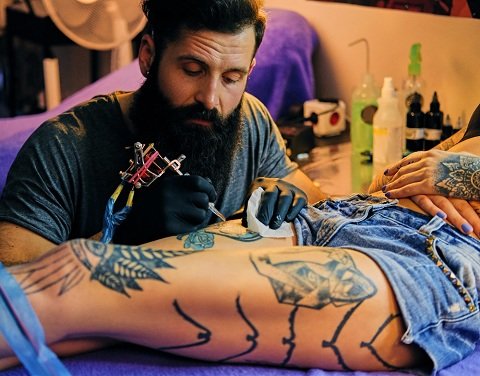





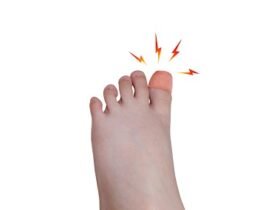
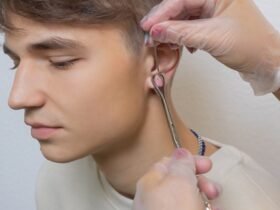


Got a Questions?
Find us on Socials or Contact us and we’ll get back to you as soon as possible.